#sileno
Text
La Scultura del giorno: Sileno e Bacco bambino
La scultura del giorno che vi propongo oggi è il gruppo di Sileno e Bacco bambino noto anche con il nome del Fauno Borghese, un tempo appartenente a Galleria Borghese ma oggi custodito nel Dipartimento delle antichità greche, etrusche e romane del Museo del Louvre.
L’opera, una delle più apprezzate della collezione Borghese, tornò alla luce con gli scavi fatti nella proprietà di Carlo Muti,…
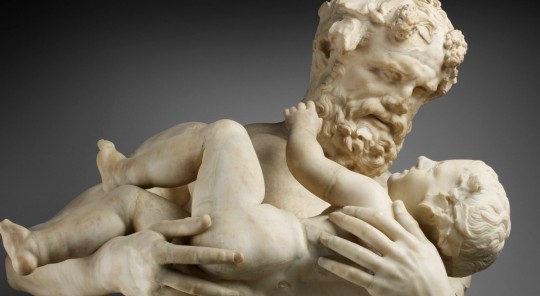
View On WordPress
#antonietta bandelloni#art#artblogger#arte#artinfluencer#artisti#Bacco#bellezza#english#Galleria Borghese#La scultura del giorno#Louvre#madeinitaly#masterpiece#napoleone#Roma#scultura#sileno
4 notes
·
View notes
Text

[2019] 23 de Julho | Carga Aérea | Sileno | Amelia Holt | Desterro - Lisboa
Cartaz [Carolina dos Santos]
#Nariz Entupido#Carga Aérea#Sileno#Amelia Holt#Desterro#Lisboa#Carolina dos Santos#Cartaz#Música#2019
0 notes
Text

No Retreat, No Surrender (Corey Yuen, 1986)
48 notes
·
View notes
Text
The Dionysos gallery (3)
We continue our journey down the gallery put together by the Museum of Wine to explore the depictions of Dionysos and his cohorts through the art... Previous item of the gallery was here. Today... Dionysos' entourage. And we begin with...
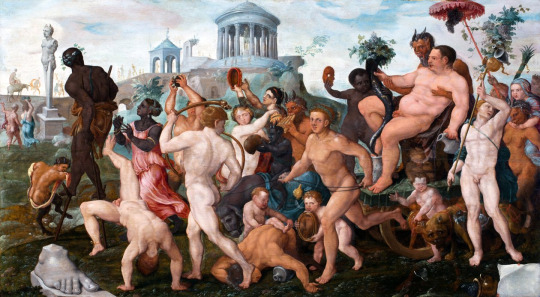
The Triumphal Cortege of Dionysos, by Maerten van Heemskerck
A) The Procession of Dionysos
(As usual all text here is loosely translated from the website)
The motif of the Procession of Dionysos, or Cortege of Bacchus, tends to be heavily inspired by Ovid's description of this triumphal parade within his Metamorphoses - but it is the culmination of Dionysos' entire earthly life.
To shield baby Dionysos from Hera's wrath, Zeus took him far away from Greece, into the land of Nisa, where he was entrusted to nymphs that raised him. Once adult, Dionysos discovered the grapevine and how to make wine. But Hera struck him with madness, and he wandered throughout Egypt and Syria, before finally reaching Phrygia where the goddess Cybele welcomed him, healed him, purified him and initiated him to her mystery cult. Now sane, he returned to Thrace where the ruling king, Lycurgus, proved himself hostile to the young man and tried to imprison him. Dionysos escaped Lycurgus by fleeing to the Nereid Thetis who welcomed him under the sea. But Lycurgus captured the Bacchants that were with Dionysos - before the god rescued them and struck Lycurgus with madness, making him cut his own leg and kill his son with an axe as he believed he was cutting Dionysos' plant, the grapevine. When Lycurgus regained his sanity, the land was cursed with sterility and the oracle announced only the king's death would return fertility to the soil: he was torn apart by four horses.
Dionysos then left Thrace to go to India. With a magical and supernatural army, he managed to wage war and conquer the land - and this is where the "triumphal procession" motif comes from, as he paraded in a (typically Roman way, since Ovid was the source of descriptions) chariot in a chariot pulled by panthers, decorated with ivy and vine, and followed by Silenos, satyrs, centaurs and Maenads.
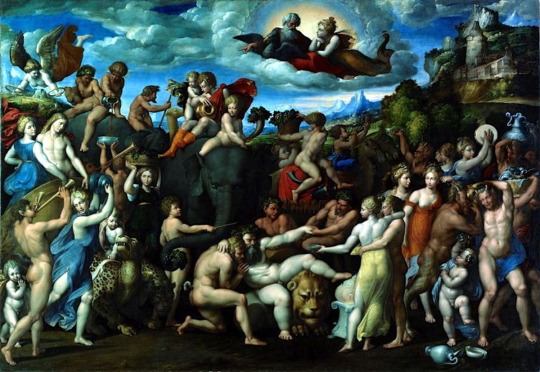
Bacchus' Triumph, by Benvenuto Tisi
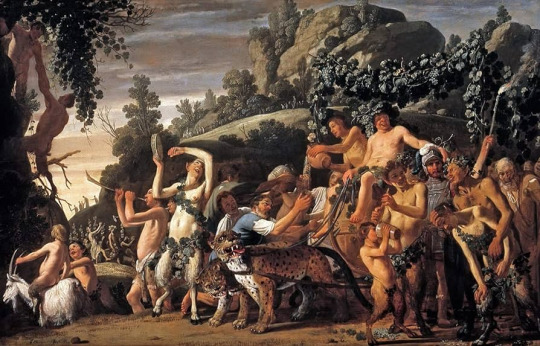
Bacchus' Triumph by Nicolaes Moeyaert
Here, Bacchus' chariot is a large barrel of wine pulled by two angry panthers. The cohorts of Dionysos are joyful and merry, drinking a lot of wine - but a few details have to be caught. To the right, there is a satyr vomitting. Behind him, there is a knight all in armor, and a sick old man visibly suffering from the gout. The painter was thus trying to warn the audience about the negative consequences of alcohol abuse: near Bacchus' procession, war and disease lurk.

Bacchus' Triumph by Nicolas Poussin
This painting depicts Dionysos' triumphal return after his victories in India. At the bottom right you can see a river-god: he symbolizes the river Indus, and by extension the entire Indian subcontinent. The Oriental nature of the journey is also shown by how a Maenad riding a horse is wearing a leopard's skin. Silenos has a vine in his hand, and while Bacchus holds a thyrsus, his traditional attribute, all the other symbols are however typical of a Roman general and of the "triumphs" of the military of Ancient Rome - for example the red cloak typical of triumphing Roman generals and Roman emperors.
B) Silenos
Silenos is both the teacher and adoptive father of Dionysos, and as such he follows him everywhere. But Silenos is also the personifiction of Drunkenness, and as such he is at the same level as the other minor deities present in Dionysos' parade, such as Comos (merriment/festivity) or Coros (Satiety). From Renaissance onward Silenos became a recurring pictural motif. Tradition depicts him as a joyful and pot-bellied old man, as ugly as he is lustful, his drunk state making him grotesque. "Silenus" also became a generic term to designate an old or elderly satyr.

The Misadventures of Silenus, by Piero di Cosimo
In this painting, Silenos actually appears three times. In chronological order, we first see him at the center of the picture. hile still riding his donkey, he tries to get honey from a hive in a hollow tree, only to be attacked by the bees. On the left we can see him being healed with berry juice, while on the right people are trying to put him back onto his feet.

Drunk Silenus, by Jose de Ribera
Here Silenos appears as an obese human. The one that holds his head is his father, the god Pan.

Drunk Silenus, by Pierre Paul Rubens
C) Satyrs
The satyrs are ambiguous creatures, half-goat half-man, who lived in the wilderness. Associated with the Maenads, they formed together the "Dionysian cortege" that paraded with the god. They are also associated with the god Pan. They are frequently hanging out or flirting with nymphs, minor deities renowned for their youth and beauty. Nymphs are female spirits that inhabit most places within the landscapes: they are found within woods and forests, in valleys and meadows, by streams and rivers, in mountains and grottos... They are also typically associated with various major deities - including Dionysos.

Nymph and Satyr, by Christiaen van Couwenbergh
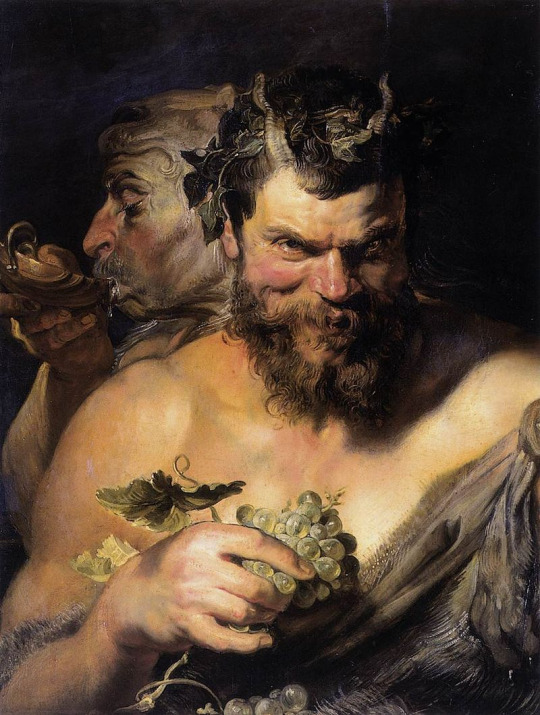
Two Satyrs, by Peter Paul Rubens

Satyr drinking the juice of a pressed grape, by David de Haen
D) Maenads and Bacchants
The Maenads are the female followers of Dionysos, who escort him in all of his adventures, including his journey to India. They are his servants, not his priestesses, but they do have an important role in his religion and in his worship. They participate to all the mysteries and all the festivals in honor of the god. They are dressed with lion skins, their chest bare, and they hold the thyrsus, a lance surrounded by ivy. They personify the orgiastic spirits of nature, and are renowned for their frenetical dances that place them in a mystical ecstasy. Some heroes fell victim to their inhuman strength - the Bacchants (Roman name of the Maenads) were known to act like ferocious and savage beasts.

The Dance of the Bacchants, by Charles Gleyre

Pentheus hunted by the Maenads, Charles Gleyre
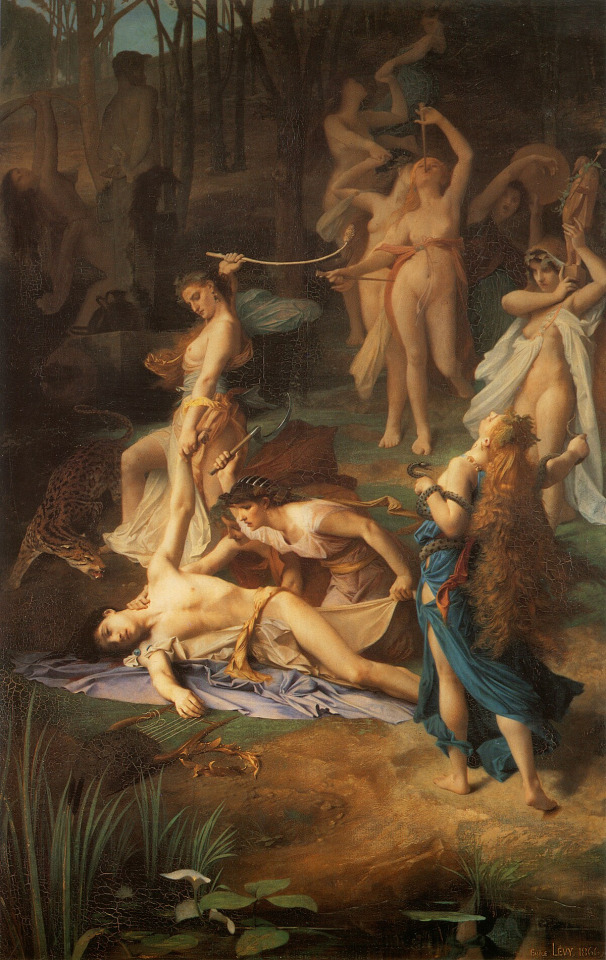
The Death of Orpheus, by Emile Lévy
E) Centaurs
The centaurs are creatures appearing as half-men half-horses. They are part of the Dionysian procession, and for the Ancient Greek they symbolized all of the bestial appetites (drunkenness and lechery). Their fight against the Lapiths was an allegory for the fight between civilization and savagery.

The Battle of the Lapiths and the Centaurs, by Piero di Cosimo
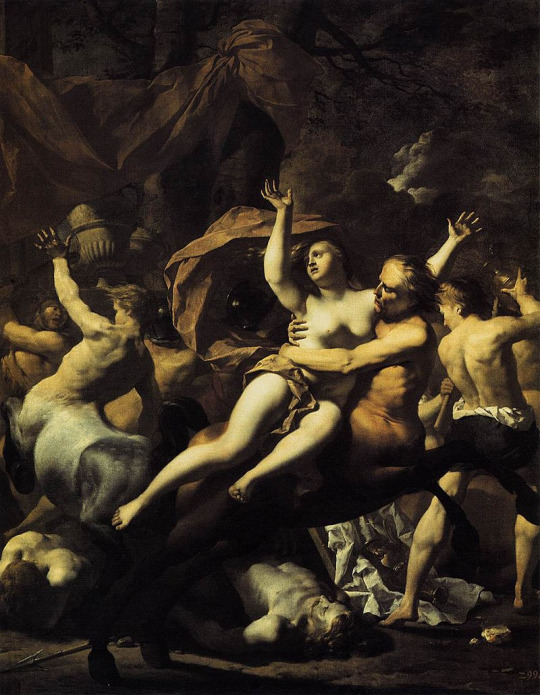
The Battle of the Lapiths and the Centaurs at the wedding of Hippodomy, by Karel Dujardin

Battle between the Lapiths and the Centaurs, by Lucas Giordane
These three paintings depict the same legend. Pirithoos married Hippodamia and invited all the Olympian gods to his wedding. However, since there were most guests than the palace could contain, Pirithoos had to place several of them within a cavern nearby - a fresh and shadowy, very pleasant grotto. Within this cavern were Nestor, Caeneus and several Thessalian princes, alongside Pirithoos' cousin the Centaurs. The Centaurs were not used to drinking wine. Upon sensing its smell, they rejected the fermented milk they had been offered, and swallowed all the wine. But in their ignorance, they took the wine without cutting it with water as it was tradition - as such, they took pure alcohol, and became so drunk that when the bride arrived with her handmaidens to salute them, a centaur named Eurytion broke all the furniture and took her by the hair to drag her away. All the other Centaurs imitated him, snatching away all the women and girls (and young boys) they could find, and trying to rape them all. Pirithoos, with the help of Theseus, went to rescue Hippodamia - he cut off Eurytion's nose and ears and, with the help of the other Lapiths, he threw the mutilated Centaur outside of the grotto.
A battle ensued that lasted all night, and during which Caeneus the Lapith was killed. This was the start of a very long war that would forever oppose the Centaurs and their neighbors the Lapiths.
F) A last thought

André Lhote's "Bacchant"
The character of the Bacchant reappeared within the art of the 19th century, all the way to the beginning of the 20th. Originally, the Bacchant attracted the artists in its role of member of the procession of Bacchus, the thiasis - the Bacchant (or Maenad) is primarily the priestess of Bacchus/Dionysos, and has specific attributes: a skin belonging to a wild animal (usually a panther), a cup of wine, a crown of ivy or vine, a thyrsus... But the Bacchant of the 19th century, entirely devoted to the service of the god of wine, becomes a being of flesh. She listens and obeys to her impulses, she shows a savage sensuality, she offers to the artists the possibility to depict an ecstatic, equivocal nudity - not to say licentious. Slowly, painters and sculptors will use the myth as an excuse to depict the eroticism of a body arching and rearing. The bacchant loses her mythological attributes, and becomes simply a naked woman, free from all constraints. However, the idea of drunkenness and sensuality is well-kept.
The Bacchant of André Lhote is an exemple of this new Bacchant: she is a naked and fleshy woman with generous curves. In a posture of lascivity and complete abandon, she eats grapes in honor of Bacchus within a rural landscape. She celebrates the sensuality of the pleasures of life. Rodin created on the same motif erotic drawings that he called "Bacchant". Indeed, to call a naked, sexual model a "Bacchant" was a way to avoid the fury of the numerous "Leagues of Virtue". This results in the ambiguity of the title, since the modern Bacchant is very different from her Antic sister, even though they are united by the presence of wine and grapes.
#the art of the myth#dionysos#the dionysos gallery#bacchant#maenad#dionysus#greek mythology#satyrs#silenus#silenos#dionysos gallery#centaurs
7 notes
·
View notes
Photo
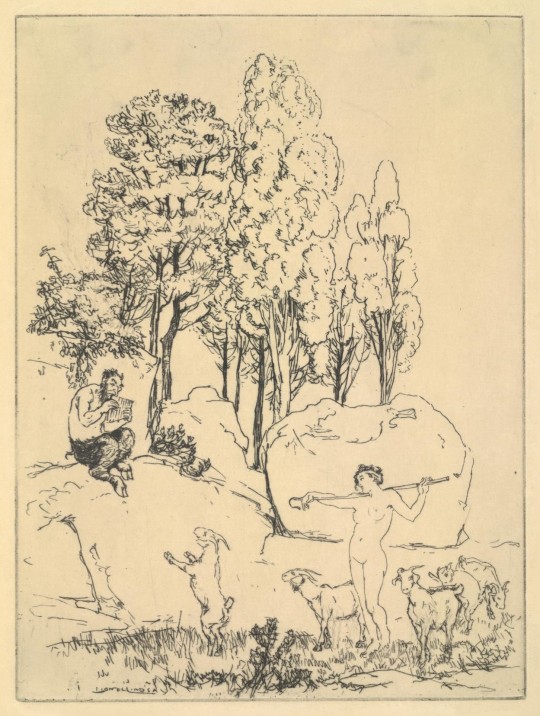

Lionel Lindsay (1874 – 1961) - Evensong, 1917, etching and plate tone; Diana Hunting, 1907, etching and acquatint
#Lionel Lindsay#Sir Lionel Arthur Lindsay#goats#pan#satyr#greek mythology#mythical beast#panpipes#illustration#vintage illustration#silenos#nature spirit#1910s#1917#australian artist
13 notes
·
View notes
Note
If you are still doing this and have the time, may i ask for a prayer to Silenos? Thank you and i wish you a beautiful rest of the week💜
song is brought to you in offering, Silenos
and tartest wine is poured in your name.
merry god, found within the deepest tangles of ivy -
you compel feet to move and laughter to bubble.
this relief that is sought is one only your fine hand can bring.
come as a companion, wine-drunk Silenos, as you do to the maddening Dionysos,
and may your presence be known by the echo of the pound of your dancing feet.
(11 July 2022)
#sorry this took so long i took a break from socials#ty for the request!#Silenos#my poetry#hellenic polytheism#personal#asks
10 notes
·
View notes
Text
Gift art for @solest ‘s birthday of her OC Silenos!
My fav pretty muse boi ;v; <3
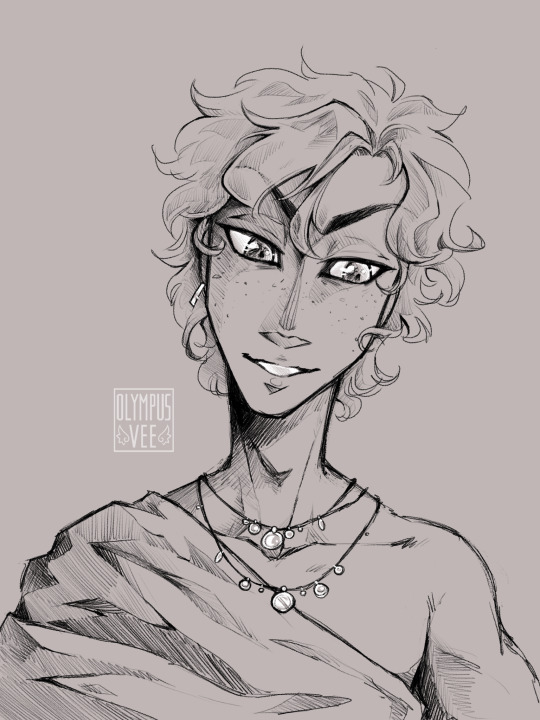
6 notes
·
View notes
Text

Statue of a Young Satyr Wearing a Theater Mask of Silenos, Art Institute of Chicago (Illinois)
Photographer: Art Poskanzer
#art poskanzer#photographer#ancient#flickr#classical#history#sculpture#statue#young satyr wearing a theater mask of silenos#art institute of chicago#illinois
1 note
·
View note
Text
Quite Literally Blown Away
Travel with Sarah, our art history blogger, to Chicago! Visiting the Art Institute and touring the city to find the beautiful greek statues and incredible architecture that the city has to offer. #MarywoodArt #Chicago #AnishKapoor #GreekArt
For those that don’t know me well or haven’t talked to me recently, I should start this by informing you that I recently returned from my 5th year studio field trip to Chicago. (It was really windy there, by the way. I wish someone had warned me; they should really pop a label on there or something for the windiness of this city). Now that you know that, you must really not know me if you didn’t…

View On WordPress
#Art#Art History#art institute#Art Institute of Chicago#Chicago#greek art#Illustration#inspiration#marble statue#Marywood Art#Marywood Art Department#Marywood University#Marywood University Art Department#Painting#Photography#Silenos#Where Creativity Works#young satyr
0 notes
Text
Satyr
Let’s take a break from the mundane cartoon people I’ve been posting. I’ll come back to them, don’t worry. (I have 150 of them, after all.) But for today, I bring you Greek mythical creatures. Cute ones. I have four to share. Here’s the first one, a satyr.
4 figures isolated on seperate colored backgrounds. The upper left is a satyr, upper right is a gorgon, lower left is a siren, and lower…

View On WordPress
#art sample#cartoon#cute#drawing#greek myth#Hand on hip#illustratoin#illustrator#isolated on green#karen b jones#mythical creature#mythology#pan#satyr#silenos#silenus#standing#winking
0 notes
Text
Greek Gods 101: A Masterlist
This is a masterlist of the “Greek Gods 101” series. This series aims to provide basic information and worship ideas for both major and minor deities. This masterlist also involves heroes, deified mortals, spirits, and other figures of Greek mythology.
Aceso
Acheron
Acratos
Aedos
Aegle
Aeolus
Aether
Aglaea
Akhlys
Ampelus
Amphitrite
Ananke
Anemoi
Angelia
Anteros
Antheia
Aphrodite
Apollon
Aporia
Ares
Arete
Ariadne
Aristaeus
Artemis
Asklepios
Asteria
Astraeus
Astrape
Athena
Atlas
Bia
Britomartis
Calliope
Carpi
Cassandra
Ceraon
Cerberus
Ceto
Chaos
Charon
Chione
Chiron
Chloris
Chrysos
Circe
Clio
Clymene
Comus
Cratus
Cronos
Daphne
Deimus
Deipneus
Demeter
Dicaeosyne
Dike
Dionysus
Dysnomia
Ececheria
Eileithyia
Eirene
Ekho
Electryone
Eleos
Elpis
Endymion
Enyo
Eos
Epiales
Epione
Epiphron
Erato
Erebus
Eris
Eros
Ersa
Eucleia
Eudaemonia
Eunomia
Eupheme
Euphrosyne
Euporia
Eupraxia
Eurybia
Eurydice
Eusebia
Euterpe
Euthenia
Eutychia
Fates
Furies
Gaea
Ganymedes
Gelus
Hades
Harmonia
Harpocrates
Hebe
Hecate
Hedone
Hedylogus
Helius
Hemera
Hephaestus
Hera
Heracles
Hermaphroditus
Hermes
Hestia
Hesychia
Himeros
Homonoia
Horae (Seasons)
Horae (Time)
Hormes
Hybris
Hydros
Hygeia
Hymenaeus
Hypnus
Iaso
Iris
Lelantus
Lethe
Leto
Macaria
Matton
Medusa
Melinoe
Melpomene
Methe
Mnemosyne
Morpheus
Nemesis
Nike
Nyx
Oizys
Orpheus
Orthannes
Ossa
Ourania
Ouranos
Ourea
Paeon
Paidia
Palaemon
Pallas
Pan
Panacea
Pandaisia
Pandora
Pannychis
Panopia
Paregoros
Pasithea
Pegasus
Peitho
Penia
Penthus
Persephone
Perses
Perseus
Phales
Phanes
Phaunus
Pheme
Philophrosyne
Philotes
Phobus
Phoebe
Phorcys
Phthonus
Phusis
Pistis
Plutus
Poena
Polemus
Polymnia
Pompe
Pontus
Ponus
Porus
Poseidon
Pothus
Priapus
Prometheus
Pronoea
Prophesis
Psamathe
Pseudologoi
Psyche
Ptocheia
Rhea
Selene
Silenos
Sophrosyne
Soter
Soteria
Styx
Tartarus
Telesphorus
Terpsichore
Tethys
Thalassa
Thalia
Thalia
Thallo
Thanatus
Thaumas
Thea
Themis
Theseus
Thesis
Thrasus
Thyone
Tithonus
Triptolemus
Triton
Tritopatores
Tyche
Tychon
Urania
Uranus
Zelus
Zeus
What is a “Universal Offering/Devotional Act?”
Feel free to request or suggest deities! This list will be done in order but you can ask for me to complete one that’s further down the list.
This list is subject to change. There are probably repeat deities (deities who go by multiple names, parts of groups like the Horae or Charities who are mostly grouped together, etc.) on this list. Some deities are not on here. Some names are spelt wrong or different.
#masterlist#masterpost#greek gods 101#deities#hellenism#helpol#hellenic#hellenic pagan#hellenic polytheism#hellenic community#hellenic polytheist#hellenic deities
1K notes
·
View notes
Text
Daily Devotions with the Orphic Hymns
Today is 4th of Metageitnion (21st of August)
This modern system of daily devotions blends material from two sources: Hesiod's sacred month, as described in his Works and Days, and the Orphic Hymns. The ideas in the Orphic Hymns sometimes don't match with more mainstream beliefs of the polis. But using these hymns is worth it because it helps us honor not just the main gods, but also many smaller ones. This way, we can pay our respects to a wide range of gods throughout the whole month.
Other hymns may of course be substituted at the individual's discretion. The numbers given for the hymns correspond to those in Apostolos N. Athanassakis, The Orphic Hymns: Text, Translation and Notes
Thomas Taylor's 1792 translation of the hymns is available online, free and in its entirety, at the Internet Sacred Texts Archive. Here:
Morning and Evening Devotions
Morning
Wash hands and face
Light lamp or candle
Hymn to Hestia (#84)
Light incense
Hymn to Eos (#78)
Hymn to Helios (#8)
Hymn(s) to special god/dess(es) of the day (see chart)
Additional hymns as desired (see chart)
Pour libation
Make personal supplications and thanksgivings
"Orpheus to Mousaios" (pp. 2-5)
Extinguish lamp or candle
Evening
Wash hands and face
Light lamp or candle
Hymn to Hestia (#84)
Light incense
Hymn to Nyx (#3)
Hymn to Selene (#9)
Hymn to the Stars (#7)
Hymn(s) to patron/matron god/desses
Hymn to Sleep (#85)
Hymn to Dream (#86)
Pour libation
Make personal supplications and thanksgivings
Hymn to Zeus (#15)
Extinguish lamp or candle
A shortened version of the devotions may be done by simply lighting a candle, reading "Orpheus to Mousaios," saying any personal prayers, and extinguishing the candle.
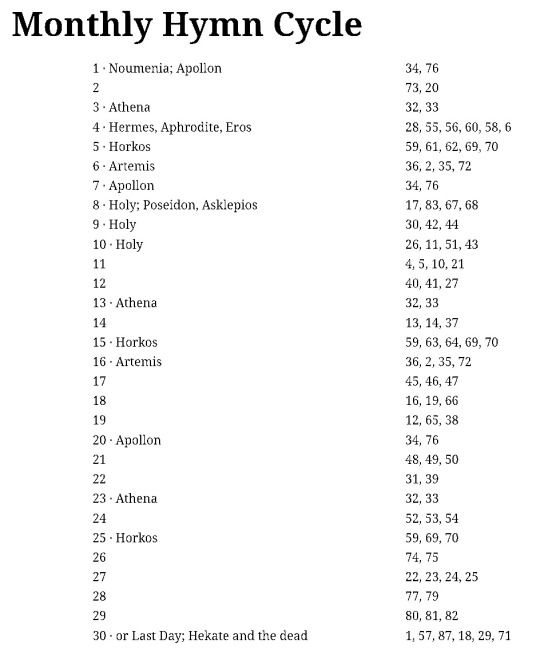
Notes on chart:
Days mentioned by Hesiod as sacred to specific deities are marked.
Horkos is the god (or, if you like, personification) of Oath. Days sacred to this deity are considered difficult.
As the lunar calendar months range between 29 and 30 days in the Greek reckoning, it may be necessary in short months to recite all the hymns for both day 29 and day 30 on the day of the dark moon. As the last day of the month is sacred to Hekate, Her hymn should always be included.
About Incense
The Orphic Hymns specify particular types of incense to be offered to each deity. In cases where one is saying multiple hymns with differing instructions, one might either choose a single type or make a blend of all those indicated. Pure frankincense makes a good all-purpose offertory incense.
The incense specifications from the Orphic text are as follows:
Frankincense: Apollon, Ares, Artemis, Asklepios, Bakkhai, Dike, Eos, Hephaistos, Herakles, Hermes, Hygeia, Kouretes, Muses, Nike, Satyros, Silenos, Tethys, Themis, Titans
Myrrh: Leto, Nereus, Poseidon
Storax: Chthonic Hermes, Dionysos, Eleusinian Demeter, Erinues (also frankincense), Graces, Kronos, Semele, Zeus
Aromatic Herbs: Adonis, Athena, Eros, Eumenides, Fates, Hera, Hestia, Horai, Nereids, Nymphs, Okeanos, Rhea
Various: Mother of the Gods, Pan, Chthonic Dionysos (any except frankincense), Gaia (any grain; no beans or aromatic herbs)
No Incense (underworld deities): Hekate, Nemesis, Persephon
#paganlife#pagan community#pagans of tumblr#paganblr#hellenism#hellenic polythiest#hellenic pagan#hellenic polytheism#hellenic polytheist#hellenic deities#hellenist#hellenic gods#greek gods#paganism#polytheist#polytheistic#greek polytheism
234 notes
·
View notes
Text

Gold ring with the head of Silenos, Etruscan, 425-350 BC
from the J. Paul Getty Museum
143 notes
·
View notes
Text


8) Folklore: Silenos is a satyr. When he tries to disguise himself as human, he is often mistaken for Morgan Freeman.
#the sims 4#ts4#simblr#bobaween#bobaween cas challenge#bobaween challenge#simblreen#simblreen 2023#simblreen cas challenge#simblreen challenge#simblreen sim#satyr sim#faun sim#halloween#halloween sim#show us your sims#showusyoursims#sims4#sims 4#sims 4 community#sims4 challenge#cas challenge
18 notes
·
View notes
Photo
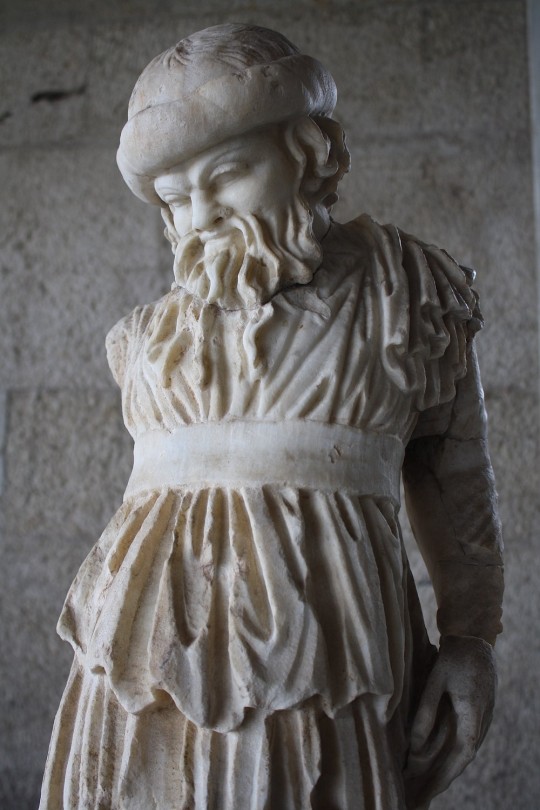
Silenus
Silenus (also spelt Silenos) is a rustic god of the forest, drunkenness and wine-making in Greek mythology. He is best known as the companion and foster father of the god Dionysos. Silenus is closely associated with the satyrs, sometimes listed as the oldest and the wisest satyr.
Continue reading...
53 notes
·
View notes
Photo

Cuidado com o que deseja, pode vir a se tornar realidade. Aliás, nas #histórias com os "gênios da lâmpada" que não foram romantizadas isso é muito ilustrado: as #consequências das realizações do desejo impensado, causam bastante #confusão. Aliás, lembrei agora que na #mitologia temos uma personagem assim: Midas é uma figura da mitologia grega, famosa por ser o rei que transformava tudo o que tocava em ouro. A história de Midas é um exemplo clássico de uma narrativa #moral que ilustra os perigos da #ganância e as #consequências de se #desejar riqueza acima de tudo. Segundo a lenda, Midas era um rei da Frígia, uma antiga região localizada na atual Turquia. Ele ajudou Sileno, um sátiro e companheiro do deus do vinho Dionísio, a encontrar seu caminho de volta para casa depois de se perder. Como #recompensa pela #bondade de Midas, Dionísio concedeu-lhe um desejo. Midas, desejando riqueza e #prosperidade, pediu que tudo o que tocasse se transformasse em ouro. Dionísio concedeu seu desejo, e Midas rapidamente percebeu que sua nova habilidade era mais uma #maldição do que uma #bênção. Quando tentou #comer, a comida se #transformava em ouro assim que a tocava, e quando abraçou sua filha, ela também se transformou em uma estátua de ouro. #Desesperado, Midas implorou a Dionísio para que revertesse a maldição. Dionísio, sentindo pena do rei, instruiu-o a se lavar no rio Pactolo para se livrar do toque dourado. Midas seguiu as instruções e, ao se banhar no rio, suas habilidades #mágicas desapareceram, e ele recuperou sua vida normal. A história de Midas serve como uma lição sobre os perigos da ganância e a importância de #valorizar as coisas simples da #vida, como #amor, #amizade e #saúde, em vez de buscar riquezas materiais. E aqui, o nosso querido dinossauro, também conseguiu a fama. É assim que você tem lidado com aquilo que deseja? Vem falar disso em sessões de terapia. Acho que é um caminho interessante para trabalhar os seus pedidos. 😉🫣 Acesse https://psico.online e agende suas sessões de #terapia online com #psicólogos e #psicólogas que podem ajudar. #midas #ouro #desejo #lenda #lendas #dinossauro (em Dura Realidade) https://www.instagram.com/p/Cp2eQJSsMTw/?igshid=NGJjMDIxMWI=
#histórias#consequências#confusão#mitologia#moral#ganância#desejar#recompensa#bondade#prosperidade#maldição#bênção#comer#transformava#desesperado#mágicas#valorizar#vida#amor#amizade#saúde#terapia#psicólogos#psicólogas#midas#ouro#desejo#lenda#lendas#dinossauro
17 notes
·
View notes